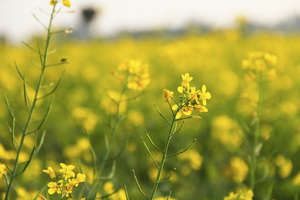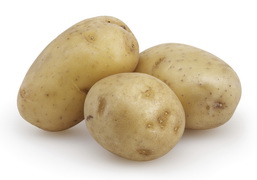CROP BIOTECH UPDATE
---------------------------------------------------------------------------
A weekly summary of world developments in agri-biotech for developing countries, produced by the Global Knowledge Center on Crop Biotechnology, International Service for the Acquisition of Agri-biotech Applications SEAsiaCenter (ISAAA)
---------------------------------------------------------------------------
May 17, 2017
In This Week’s Issue:
News
Americas
• USDA APHIS Extends Comment Period for Nonregulated Status GM Canola
• Obama Talks about Benefits of Agri-biotech
• Competition Turns On Plant Genes
Asia and the Pacific
• Australian OGTR Invites Comments for Field Trial of GM Sorghum
• Indian Farmers May Soon Adopt Indigenously Developed Insect Resistant Cotton
• India's GEAC Approves GM Mustard for Commercial Planting
Europe
• DEFRA Approves GM Potato Field Trials
Research
• Overexpression of Galactinol Synthase Gene Improves Drought Tolerance in Rice
• Improvement of Salt Tolerance in Tobacco via Overexpression of TaFBA1 Gene from Wheat
• Researchers Show How Sugarcane Produces More Sucrose
New Breeding Technologies
• Researchers Study Type III-A CRISPR-Cas System as DNA Targeting Modules
• Cell Penetrating Peptide-Mediated Delivery of CRISPR-Cas System
Beyond Crop Biotech
• Oxitec Develops GE Moths to Vegetable Pest
• TALEN-Mediated Knock-in Genome Editing in Silkworm
Document Reminders
• Biotech Crop Highlights in 2016
----
NEWS
----
Americas
USDA APHIS EXTENDS COMMENT PERIOD FOR NONREGULATED STATUS GM CANOLA
The United States Department of Agriculture's Animal and Plant Health Inspection Service (USDA APHIS) is extending the comment period for their previous notice to the public. Hence, APHIS have reached a preliminary decision to extend the determination of nonregulated status of InVigor® MS8 canola (hereinafter MS8 canola) to Bayer's canola event MS11 in response to a request from Bayer CropScience LP.
The comment period for the notice published on April 12, 2017 (82 FR 17625) is extended, and all comments will be considered on or before May 30, 2017.
MS11 canola is genetically engineered for male sterility and resistance to the herbicide glufosinate-ammonium using the same mechanism of action as MS8 canola. This action will allow interested persons additional time to prepare and submit comments on the draft environmental assessment, preliminary regulatory determination, preliminary finding of no significant impact, and plant pest risk similarity assessment for the proposed determination of nonregulated status.
For more details, go to the USDA APHIS BRS Federal Register Notices. The Federal notice is available here.
OBAMA TALKS ABOUT BENEFITS OF AGRI-BIOTECH
"The truth is humanity has always engaged in genetic modifications…The rice we eat or the corn we eat or the wheat we eat does not look like what corn or rice or wheat looked like 1,000 years ago," said former US president, Barack Obama during a speech at the Seeds and Chips Global Food Innovation Summit in Milan, Italy on May 9, 2017. During his speech, he discussed his views on genetic modification and gene editing of food.
"This debate around genetically modified foods is, I know, a very controversial one," said Obama. "The approach that I took when I was President of the United States is in the same way that I would let the science determine my policies around climate change. I try to let the science determine my attitudes about food production and new technologies." He also said that small and medium-sized farmers would be happy to adopt technologies that will help them do things better without much additional expense. He also discussed the impact of agriculture on the environment.
Watch the video of his speech in the website of Genetic Literacy Project.
COMPETITION TURNS ON PLANT GENES
 A group of researchers from the University of Michigan and University of California Davis studying the sociability of clovers have found that a single gene coding for UDP-glucose flavonoid 3-O-glucosyltransferase plays a key role in plant diversity and competition.
A group of researchers from the University of Michigan and University of California Davis studying the sociability of clovers have found that a single gene coding for UDP-glucose flavonoid 3-O-glucosyltransferase plays a key role in plant diversity and competition.
The coded flavonoid enzyme was found to be involved in many plant interactions, including those with nitrogen fixing bacteria. The researchers found that the gene's transcript levels rise when the plants compete with others and decrease when surrounded by members of the same plants. Another result involved the correlation of the genes. What made the UDP-glucose flavonoid 3-O-glucosyltransferase gene stand out so prominently is that all of the other genes responding to different types of competitors stayed grouped together. The team initially thought the genes would be scattered everywhere, but they reacted the same way.
For more details about this research, read the news release from the MSU Today.
Asia and the Pacific
AUSTRALIAN OGTR INVITES COMMENTS FOR FIELD TRIAL OF GM SORGHUM
The Australian Office of the Gene Technology Regulator (OGTR) invites comments from the public to assess license application DIR 153 from The University of Queensland for a field trial (limited and controlled release) of sorghum genetically modified for grain quality traits.
The trial is proposed to take place between October 2017 and June 2020 in southeast Queensland. During the first year, one site would be planted with an area of up to 1 hectare. In each of the second and third years, up to 4 sites would be planted with a combined area of up to 5 hectares. The GM sorghum would not be used in human food or sold as animal feed.
A consultation Risk Assessment and Risk Management Plan (RARMP) has been prepared, and a range of draft license conditions would limit the size, locations and duration of the release, as well as restrict the spread and persistence of the GMOs and the introduced genetic material. The Regulator invites written submissions to finalize the RARMP which will then inform the decision on whether or not to issue the license. The consultation RARMP and related documents are available in the OGTR website.
For more details, read the DIR 153 documents available at the OGTR website.
INDIAN FARMERS MAY SOON ADOPT INDIGENOUSLY DEVELOPED INSECT RESISTANT COTTON
Three genetically modified (Bt) and indigenously developed varieties of cotton seeds are expected to be commercially released in India for the first time. According to government officials, the cotton seeds PAU-1, RS 2013, and F-1861 have been recommended by the Indian Council of Agricultural Research (ICAR) for commercial release. The seeds can be re-used by farmers in the following planting seasons and are expected to be available in cheaper prices than the current Bt cotton varieties in the market. The average yield of the seeds is estimated at 500kg per hectare, which is higher than the yield of conventional cotton seeds and close to the average yield of existing Bt cotton seeds.
"We welcome the move to commercially release indigenously produced Bt cotton but it remains to be seen whether this is parallel to the existing BG-2. If priced significantly lower than existing seeds, it can have some attraction among farmers, mainly in those areas where pink bollworm is not a big problem," said Kalyan Goswami, executive director of National Seed Association of India.
Read more from the Genetic Literacy Project.
INDIA'S GEAC APPROVES GM MUSTARD FOR COMMERCIAL PLANTING
 The Genetic Engineering Appraisal Committee (GEAC), India's GM crop regulator has recommended the commercial use of genetically modified (GM) mustard in a submission to the environment ministry. GEAC, which is under the Ministry of Environment, Forest and Climate Change (MOEF), reviewed a report of a sub-committee constituted to look at the safety angle.
The Genetic Engineering Appraisal Committee (GEAC), India's GM crop regulator has recommended the commercial use of genetically modified (GM) mustard in a submission to the environment ministry. GEAC, which is under the Ministry of Environment, Forest and Climate Change (MOEF), reviewed a report of a sub-committee constituted to look at the safety angle.
The Centre for Genetic Manipulation of Crop Plants (CGMCP) and Delhi University South Campus, submitted an application to the GEAC in 2015 for the environmental release of GM mustard (Brassica juncea) hybrid Dhara Mustard Hybrid-11 (DMH-11) and the use of parental events (bn 3.6 and modbs 2.99 with barnase, barstar and bar genes) for the development of new hybrids. If approved, GM mustard will be the second GM crop to be planted in India, after Bt cotton's approval for commercial planting in 2004.
The environment ministry received over 750 comments from various stakeholders, including students, farmers, and researchers on the Assessment of Food and Environmental Safety (AFES) report on GM Mustard, which it had earlier posted on the ministry website. The report contains results of a thorough assessment of the biosafety data in comparison with international assessment made by well-known regulatory agencies such as the European Food Safety Authority (EFSA), Office of the Gene Technology Regulator (OGTR), and Canadian regulatory authorities, and existing peer-reviewed scientific literature on the subject. The report also addressed the specific uses of mustard in India and concluded that GM mustard was safe and nutritious for consumption.
Related information is available from The Press Trust of India. For more about the environmental release of GM mustard, read the ISAAA Brief 52 Global Status of Commercialized Biotech/GM Crops: 2016.
Europe
DEFRA APPROVES GM POTATO FIELD TRIALS
 The United Kingdom's Department for Environment, Food and Rural Affairs (Defra) has approved The Sainsbury Laboratory's application to conduct field trials of GM potato crops on a designated trial site at the Norwich Research Park between 2017 and 2021.
The United Kingdom's Department for Environment, Food and Rural Affairs (Defra) has approved The Sainsbury Laboratory's application to conduct field trials of GM potato crops on a designated trial site at the Norwich Research Park between 2017 and 2021.
The field trials are part of TSL's Potato Partnership Project to develop a Maris Piper potato that is blight and nematode resistant, bruises less, and produces less acrylamide when cooked at high temperatures. The project is funded by the Biotechnology and Biological Sciences Research Council (BBSRC) with additional funding from BioPotatoes (UK) and Simplot (US).
Professor Jonathan Jones, group leader of the TSL's Jonathan Jones Group said, "I am delighted that we have approval for the field trials necessary to test our potato plants in standard field conditions. We anticipate that the combination of resistance genes we will test this time will be even more difficult for late blight to overcome than the single gene we previously field tested, but the proof of the pudding is in the planting."
Details of the Defra decision are available here. For more about the project, visit the TSL website.
Research
OVEREXPRESSION OF GALACTINOL SYNTHASE GENE IMPROVES DROUGHT TOLERANCE IN RICE
Enhancing drought tolerance without grain yield penalty has been a challenge for plant breeders and crop improvement. A team of researchers from the International Center for Tropical Agriculture in Colombia, and various universities and research institutions in Japan evaluated the Arabidopsis thaliana galactinol synthase 2 gene (AtGolS2). The team overexpressed the gene in rice (Oryza sativa) to confer drought tolerance and increase grain yield under dry conditions.
The developed transgenic lines had higher levels of galactinol than non-transgenic plants. The transgenics also had increased grain yield under drought conditions, which is related to the higher number of panicles, grain fertility, and biomass. Extensive confined field trials of the transgenic lines across two seasons revealed that the lines have the proven field drought tolerance. The drought tolerance was found to be associated with a higher relative water content of leaves, higher photosynthesis activity, lesser reduction in plant growth and faster recovering ability.
These provide strong evidence that AtGolS2 is can be a useful tool to reduce grain yield losses in rice under field drought stress.
For more on the study, read the full article in Plant Biotechnology Journal.
IMPROVEMENT OF SALT TOLERANCE IN TOBACCO VIA OVEREXPRESSION OF TAFBA1 GENE FROM WHEAT
The F-box protein is a major subunit of the Skp1-Cullin-F-box (SCF) complex. The team of Zhongxian Zhao from Shandong Agricultural University had previously isolated an F-box gene from wheat, TaFBA1. The team now aims to know if overexpression of TaFBA1 in tobacco plants can improve its salt stress tolerance.
The transgenic tobacco plants overexpressing TaFBA1 exhibited increases in germination rate, root elongation, and biomass accumulation under salt stress. Improvements in the photosynthetic rate and related parameters were also found in the transgenic plants. These suggest that overexpression of TaFBA1 can improve salt stress tolerance.
Furthermore, the transgenics also displayed less membrane damage, higher antioxidant enzyme activity, and less accumulation of ROS under salt stress. The transgenic plants also had lower Na+ content and higher K+ content than WT plants in leaves and roots.
This shows that the enhancement of plant salt stress tolerance may be associated with an improvement in antioxidative competition.
For more on the study, read the article in Plant Science.
RESEARCHERS SHOW HOW SUGARCANE PRODUCES MORE SUCROSE
Genetically modified sugarcane that produces more sucrose has been developed by scientists from Instituto de Biologia, Universidade Estadual de Campinas in Brazil.
To investigate how ethylene works in sugarcane, Camila Cunha and colleagues sprayed sugarcane plants with ethephon (growth regulator) or aminoethoxyvinylglycine (AVG), a ripening inhibitor before maturation. They measured the sucrose concentrations in the leaves and stems of sugarcane at the onset of ripening. Results showed that plants sprayed with ethephon had 60 percent more sucrose while those treated with AVG had 42 percent lower sucrose. The findings led the scientists to pinpoint the genes involved in the reaction of ethylene during ripening and those that regulate sucrose metabolism and accumulation.
With the results of the study, the researchers proposed a molecular model of how ethylene reacts with other hormones, which can lead to the development of most productive sugarcane varieties.
Read more details about the study from Nature Scientific Reports.
New Breeding Technologies
RESEARCHERS STUDY TYPE III-A CRISPR-CAS SYSTEM AS DNA TARGETING MODULES
The CRISPR-Cas systems provide invader defense in a wide variety of prokaryotes, as well as technologies for gene editing applications. The Type III-A or Csm CRISPR-Cas system is one of the most widely distributed across prokaryotic phyla, and cleaves targeted DNA and RNA molecules.
The team of H. Travis Ichikawa from the University of Georgia constructed modules of Csm systems from Lactococcus lactis, Staphylococcus epidermidis, and Streptococcus thermophilus. The modules include a Cas6 protein and a CRISPR locus for crRNA production, and Csm effector complex proteins. The team expressed these modules in Escherichia coli and evaluated their function. The expressed modules specifically eliminated invading plasmids recognized by their specific crRNAs.
Characteristically, activation of plasmid targeting activity depended on transcription of the plasmid sequence recognized by the crRNA. Moreover, the Csm module can also be programmed to recognize plasmids with novel target sequences by adding appropriate crRNA coding sequences to the module.
These systems provide a platform for evaluation of Type III-A CRISPR-Cas systems in E. coli and for use as programmable transcription-activated DNA targeting system for novel organisms.
For more on this study, read the article in PLOS One.
CELL PENETRATING PEPTIDE-MEDIATED DELIVERY OF CRISPR-CAS SYSTEM
 CRISPR-Cas9 allows genome editing in a variety of species. However, many cell types and tissues are resistant to the delivery techniques of the CRISPR-Cas9 complex, limiting its use. The team of David S. Axford from the Kennesaw State University in Georgia introduced a cell-penetrating peptide (CPP) adaptor, TAT-CaM, which allows cytoplasmic delivery and release of a wide variety of biomolecular cargos. The integration of CRISPR-Cas9 using CPP-mediated delivery could make the system much more widely usable.
CRISPR-Cas9 allows genome editing in a variety of species. However, many cell types and tissues are resistant to the delivery techniques of the CRISPR-Cas9 complex, limiting its use. The team of David S. Axford from the Kennesaw State University in Georgia introduced a cell-penetrating peptide (CPP) adaptor, TAT-CaM, which allows cytoplasmic delivery and release of a wide variety of biomolecular cargos. The integration of CRISPR-Cas9 using CPP-mediated delivery could make the system much more widely usable.
The team expressed a recombinant Cas9 containing a calmodulin binding site (CBS-Cas9) in Escherichia coli. These TAT-CaM/CBS-Cas9 complexes were then evaluated for their cell penetrating capabilities. After cell penetrating capability and subcellular localization were assessed, a nuclear localization sequence was added to the gene encoding Cas9 to enhance nuclear localization of the Cas9, making it more effective in editing genes.
Due to the success of the complexes, several other CPPs and adaptor proteins and model cargos with subcellular localization signals were also assayed in hopes of developing CPP-adaptor deliveries with altered destinations. Future work could integrate these results into an effective CRISPR-Cas9 delivery and gene editing system.
For more on this study, read the article in FASEB Journal.
Beyond Crop Biotech
OXITEC DEVELOPS GE MOTHS TO VEGETABLE PEST
Cornell University and Oxitec company, the developer of genetically engineered mosquitoes designed to stop Zika and other diseases, are now set to test genetically engineer male diamondback moth. Similar with the GE mosquitoes developed by Oxitec, engineering of moths is focused on males to lessen the population of the pest. The GE moths have passed the laboratory and greenhouse trials. US Food and Drug Administration officials are currently reviewing whether to allow open field trials of the GE moths. At present, diamondback moth has shown resistance to 95 different pesticides. Thus, it is a huge concern of vegetable farmers worldwide.
Read more from Wired.
TALEN-MEDIATED KNOCK-IN GENOME EDITING IN SILKWORM
Genome editing is a powerful tool for the analysis of targeted genes. Takuya Tsubota and colleagues from the National Agriculture and Food Research Organization in Japan previously found that a novel knock-in system, precise integration into target chromosome (PITCh), allows the integration of a donor vector with the hsp90 promoter and GFP into the silkworm biogenesis of lysosome-related organelles complex 1, subunit 2 gene.
Then the team evaluated whether the same technique can be used for the knock-in of other silkworm genes. The silkworm ku80 gene was selected as a target and was efficiently mutated using a pair of transcription activator-like effector nucleases (TALENs).
Microinjection of TALEN mRNAs mixed with the donor vector resulted in significant expression of the GFP marker in G0 larvae. GFP expression was detected in G1 individuals, suggesting that the integrated donor vector can be inherited in the next generation. It was further found to be inherited in the G2 generation.
The PITCh system offers a versatile tool for the knock-in of various genes, and could contribute to the further promotion of sericultural studies.
For more information on this study, read the article in Journal of Insect Biotechnology and Sericology.
Document Reminders
BIOTECH CROP HIGHLIGHTS IN 2016
ISAAA released the Pocket K version of the report on the Global Status of Commercialized Biotech/GM Crops: 2016 (ISAAA Brief 52). The Pocket K titled Biotech Crop Highlights in 2016 summarizes the main topics of the report including the global area of biotech crops (1996-2016), biotech crops in industrial and developing countries, distribution of biotech crops in 26 countries, and global value of biotech crops.
Pocket Ks are Pockets of Knowledge, packaged information about crop biotechnology products and related issues. It is developed by the Global Knowledge Center on Crop Biotechnology to deliver key agri-biotech information in easy-to-understand style and downloadable as PDF for easy sharing and distribution.
Also available: Highlights of the 2016 ISAAA Report (video).
(c) 2024. ISAAA.
 A group of researchers from the University of Michigan and University of California Davis studying the sociability of clovers have found that a single gene coding for UDP-glucose flavonoid 3-O-glucosyltransferase plays a key role in plant diversity and competition.
A group of researchers from the University of Michigan and University of California Davis studying the sociability of clovers have found that a single gene coding for UDP-glucose flavonoid 3-O-glucosyltransferase plays a key role in plant diversity and competition.  The Genetic Engineering Appraisal Committee (GEAC), India's GM crop regulator has recommended the commercial use of
The Genetic Engineering Appraisal Committee (GEAC), India's GM crop regulator has recommended the commercial use of  The United Kingdom's Department for Environment, Food and Rural Affairs (Defra) has approved The Sainsbury Laboratory's application to conduct field trials of
The United Kingdom's Department for Environment, Food and Rural Affairs (Defra) has approved The Sainsbury Laboratory's application to conduct field trials of  CRISPR-Cas9 allows
CRISPR-Cas9 allows